Mexican Architecture: Bright and Colorful
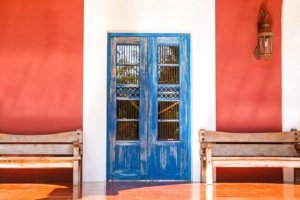
Mexican architecture is original, eye-catching and beautiful. It’s unlike any other architectural style in the world. The use of shapes, color and light make this a really interesting style. In this article, we’ll tell you all about the main features of Mexican architecture.
Mexican architecture: shapes and structures
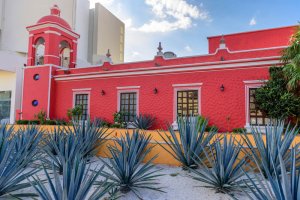
With its contemporary structures, Mexican architecture stands out. Modern Mexican architecture has become more popular recently.
The buildings and houses are large and impressive. Architects use straight lines and sharp angles. The main emphasis is placed on the shapes, heights and large windows. These play a huge role in Mexican designs.
Architects like Ricardo Legorreta, Luis Barragán and Alberto Kalach are well-known for their use of geometric forms.
They combined these shapes with interesting textures and colors. In the next section, we will focus on the typical colors and lighting used in this style. The colors and lighting also bring a sense of originality.
Colors and lighting
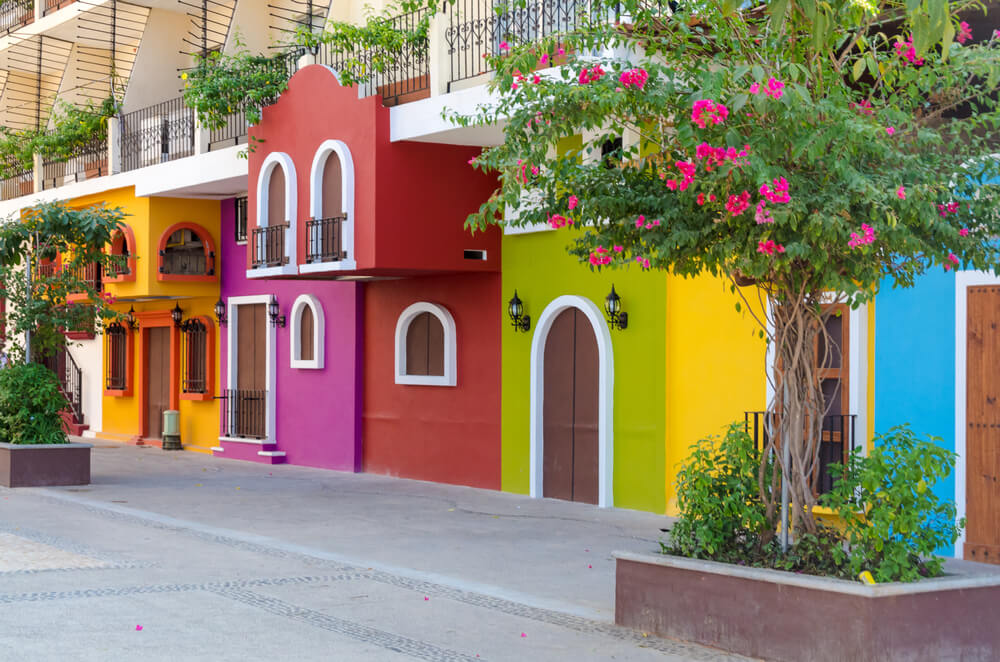
The colors are one of the most important aspects of Mexican architecture. They are the country’s hallmark, a part of their identity. You can see them in the decoration and clothing and on the facades of buildings. Mexican architects use bright, cheerful colors, which are normally made from natural dye.
The use of color
The most common colors are: yellow, orange, red, fuchsia, green and blue. They are bright colors which combine to create a unique and cheerful look.
Mexican architecture is well-known for using these bright colors on the facades of buildings. Unlike most countries, you won’t find buildings or houses with neutral tones such as white, gray, black or beige. Instead, they create interesting structures with bright, cheerful colors and textures.
Mexican buildings often combine two vibrant colors. However, you can also find some which use all the colors we mentioned in a single structure.
Hospital Infantil Teletón
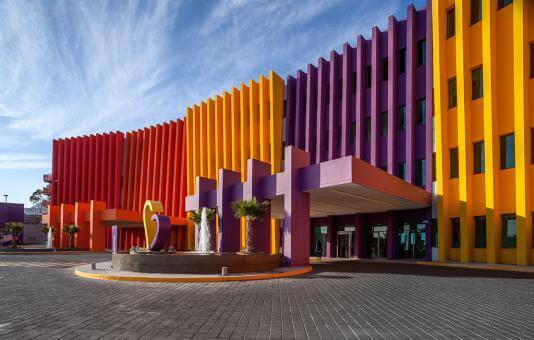
It’s also important to highlight how Mexican architects play with shape and color. Take the Hospital Infantil Teletón, in the city of Querétaro, Mexico. This impressive building has different colored sections. You’ll find yellow, orange, red, purple and fuchsia.
These sections are made up of columns, which help to filter excess light. It is an imposing and dynamic structure. Plus, the inside is designed to complement the colors of the facade and adds to the bright, joyous mood.
We should also highlight the role the lighting and colors play in this type of architecture. The light, combined with the warm, cheerful colors, create a building that is beautiful both inside and out.
House Tec 205
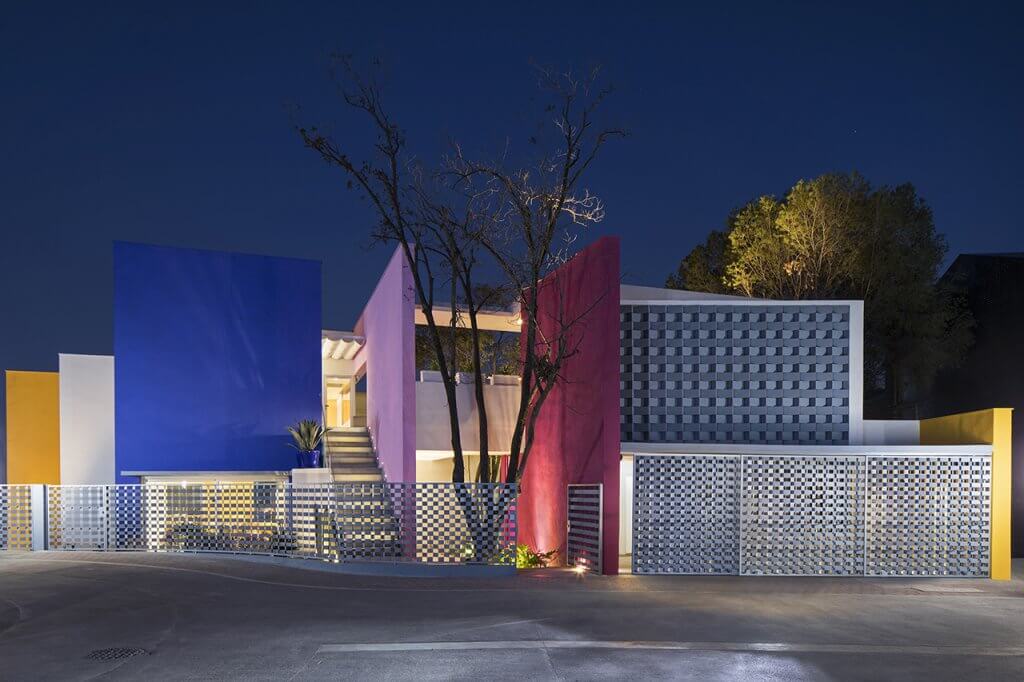
The famous House Tec 205, designed by Moneo Brock Studio, is in the city of Monterrey, Mexico. This extraordinary building is unique in the way it works with its environment. It uses colorful, vertical panels for the walls.
The fuchsia, blue, purple and yellow panels intersect the house, dividing it into its different rooms. They create a colorful and interesting environment, inside and outside the house. Plus, the building uses white throughout to act as a common thread.
With its angular shape, large windows, the alcoves which fill the property with light, and classic Mexican colors, House Tec 2o5 is a contemporary work that is famous worldwide. It achieves a visual harmony which combines the structures, colors, lighting and natural surroundings.
Inside, the play of light, shadow, and color are just as interesting as the exterior. Every room has walls of a different color.
Yellow, for example, features opposite windows where the greatest amount of light comes in. It serves to reflect and amplify the light.
There are many examples of modern Mexican architecture. They stand out for their bright, colorful nature. Furthermore, carefully thought-out shapes, colors, and windows make these buildings truly stunning.
So, if you’re planning on going to Mexico, you’ll be able to enjoy these extraordinary and colorful structures in person.
Mexican architecture is original, eye-catching and beautiful. It’s unlike any other architectural style in the world. The use of shapes, color and light make this a really interesting style. In this article, we’ll tell you all about the main features of Mexican architecture.
Mexican architecture: shapes and structures

With its contemporary structures, Mexican architecture stands out. Modern Mexican architecture has become more popular recently.
The buildings and houses are large and impressive. Architects use straight lines and sharp angles. The main emphasis is placed on the shapes, heights and large windows. These play a huge role in Mexican designs.
Architects like Ricardo Legorreta, Luis Barragán and Alberto Kalach are well-known for their use of geometric forms.
They combined these shapes with interesting textures and colors. In the next section, we will focus on the typical colors and lighting used in this style. The colors and lighting also bring a sense of originality.
Colors and lighting

The colors are one of the most important aspects of Mexican architecture. They are the country’s hallmark, a part of their identity. You can see them in the decoration and clothing and on the facades of buildings. Mexican architects use bright, cheerful colors, which are normally made from natural dye.
The use of color
The most common colors are: yellow, orange, red, fuchsia, green and blue. They are bright colors which combine to create a unique and cheerful look.
Mexican architecture is well-known for using these bright colors on the facades of buildings. Unlike most countries, you won’t find buildings or houses with neutral tones such as white, gray, black or beige. Instead, they create interesting structures with bright, cheerful colors and textures.
Mexican buildings often combine two vibrant colors. However, you can also find some which use all the colors we mentioned in a single structure.
Hospital Infantil Teletón

It’s also important to highlight how Mexican architects play with shape and color. Take the Hospital Infantil Teletón, in the city of Querétaro, Mexico. This impressive building has different colored sections. You’ll find yellow, orange, red, purple and fuchsia.
These sections are made up of columns, which help to filter excess light. It is an imposing and dynamic structure. Plus, the inside is designed to complement the colors of the facade and adds to the bright, joyous mood.
We should also highlight the role the lighting and colors play in this type of architecture. The light, combined with the warm, cheerful colors, create a building that is beautiful both inside and out.
House Tec 205

The famous House Tec 205, designed by Moneo Brock Studio, is in the city of Monterrey, Mexico. This extraordinary building is unique in the way it works with its environment. It uses colorful, vertical panels for the walls.
The fuchsia, blue, purple and yellow panels intersect the house, dividing it into its different rooms. They create a colorful and interesting environment, inside and outside the house. Plus, the building uses white throughout to act as a common thread.
With its angular shape, large windows, the alcoves which fill the property with light, and classic Mexican colors, House Tec 2o5 is a contemporary work that is famous worldwide. It achieves a visual harmony which combines the structures, colors, lighting and natural surroundings.
Inside, the play of light, shadow, and color are just as interesting as the exterior. Every room has walls of a different color.
Yellow, for example, features opposite windows where the greatest amount of light comes in. It serves to reflect and amplify the light.
There are many examples of modern Mexican architecture. They stand out for their bright, colorful nature. Furthermore, carefully thought-out shapes, colors, and windows make these buildings truly stunning.
So, if you’re planning on going to Mexico, you’ll be able to enjoy these extraordinary and colorful structures in person.







